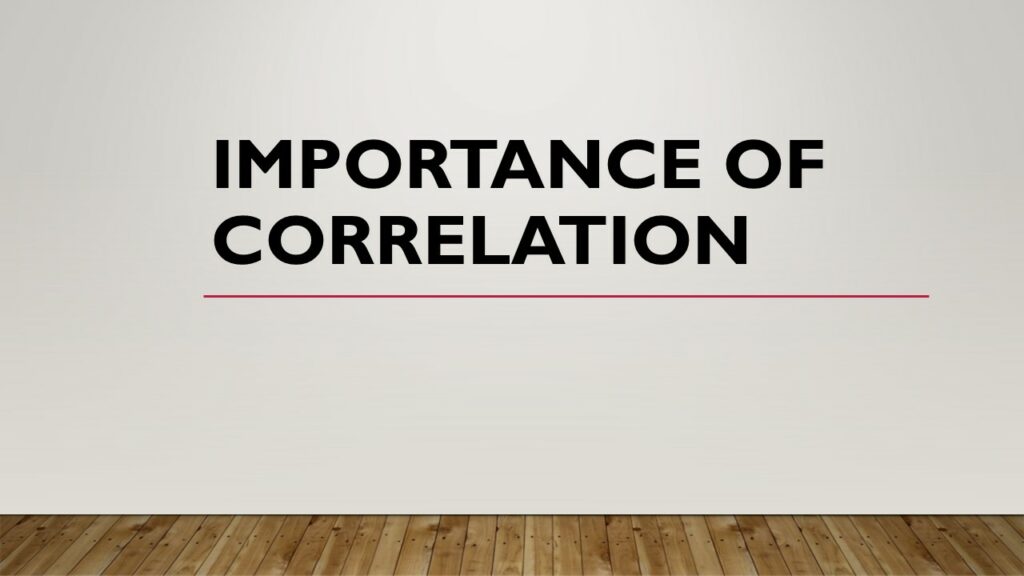Importance of correlation is as follows:
CORRELATION
Correlation is a statistical technique which shows the degree and direction of relationship between the two variables. It ranges between -1 to +1.
According to AM Tuttle
“Correlation is the analysis of co-variation between two or more variables.”
According to Croxton and Cowden
“When the relationship is of a quantitative nature, the appropriate statistical tool for discovering and measuring the relationship and expressing it in a brief formula is known as correlation.”
Thus, whenever two variables are so related that a change in the value of one is accompanied by a change in the value of the other, in such a way that
(a) an increase or decrease is one variable is accompanied by an increase or decrease in the other or
(b) a fall in one variable is accompanied by a fall or rise in the other, then the variables are said to be correlated.
SIGNIFICANCE OR IMPORTANCE OF CORRELATION
The importance or significance or utility of correlation is clear from the following points:
HELPS IN MEASURING THE EXTENT OF RELATIONSHIP: The correlation coefficient helps us in measuring the extent of relationship between two or more than two variables. The degree and extent of the relationship between two variables is, of course, one of the most important problems in statistics.
HELPS IN PREDICTIONS: It is through correlation that we can predict about the future. For instance, if there are good monsoons, we can expect better food supply and hence can expect fall in price of food grains and other products. The predictions made on the basis of correlation analysis are considered to be nearer to reality and hence reliable. In the words of Tippett. “The effect of correlation is to reduce the range of uncertainty of our prediction.”
HELPS IN STUDYING ECONOMIC BEHAVIOR: Correlation contributes to economic behaviour. It helps us in knowing the important variables on which others depend.
HELPS IN FURTHER STATISTICAL TREATMENT: The technique of ratio of variation and regression analysis depends totally on the findings of coefficient of correlation.
HELPFUL IN FIELD OF COMMERCE AND INDUSTRY: In the field of commerce and industry, the technique of correlation coefficient helps to make estimates like sales, price or costs.
The predictions made on the basis of correlation analysis are considered to be nearer to reality and hence reliable. In the words of Tippett. “The effect of correlation is to reduce the range of uncertainty of our prediction.”
Thus, the technique of correlation coefficient is the most useful tool in statistical analysis in every discipline. In the words of W.A. Neiswanger, “Correlation analysis contributes to the understanding of economic behaviour, aids in locating the critically important variables on which other depend, may reveal to the economists the connections by which disturbances spread and suggest to him the paths through which stabilising forces may become active.”
DEGREES OF CORRELATION
According to Karl Pearson, the coefficient of correlation lies between two limits i.e. +1 and -1. It implies that there is perfect positive relationship between two variables, the value of correlation would be positive one. On the contrary, if there is perfect negative relationship between two variables the value of the correlation will be negative one. It means r lies between +1 and -1. Within these limits the value of correlation can be interpreted as:
| r=+1 | Perfect Positive Correlation |
| r>+0.75 but < +1 | High degree of positive correlation |
| r>+0.5 but < +0.75 | Moderate degree of positive correlation |
| r> +0 but <+0.5 | Low degree of positive correlation |
| r=0 | No correlation at all |
| r>-0.75 but < -1 | High degree of negative correlation |
| r>-0.5 but < -0.75 | Moderate degree of negative correlation |
| r> -0 but <-0.5 | Low degree of negative correlation |
| r=-1 | Perfect negative correlation |
